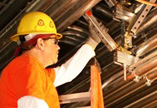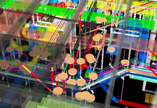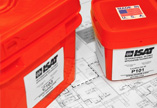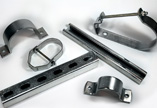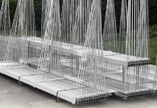ASCE 7-05 Reference Info
Seismic Ground Motion Values
11.4 SEISMIC GROUND MOTION VALUES
11.4.1 Mapped Acceleration Parameters. The parameters SS and S1 shall be determined from the 0.2 and 1.0 s spectral response accelerations shown on Figs. 22-1 through 22-14, respectively. Where S1, is less than or equal to 0.04 and SS is less than or equal to 0.15, the structure is permitted to be assigned to Seismic Design
Category A and is only required to comply with Section 11.7.
11.4.2 Site Class. Based on the site soil properties, the site shall be classified as Site Class A, B, C, D, E, or F in accordance with Chapter 20. Where the soil properties are not known in sufficient detail to determine the site class, Site Class D shall be used unless the authority having jurisdiction or geotechnical data determines Site Class E or F soils are present at the site.
11.4.3 Site Coefficients and Adjusted Maximum Considered Earthquake (MCE) Spectral Response Acceleration Parameters. The MCE spectral response acceleration for short periods (SMS) and at 1 s (SM1), adjusted for Site Class effects, shall be
determined by Eqs. 11.4-1 and 11.4-2, respectively.
where
SS = the mapped MCE spectral response acceleration at short periods as determined in accordance with Section 11.4.1,
and
S1 = the mappedMCEspectral response acceleration at a period of 1 s as determined in accordance with Section 11.4.1
where site coefficients Fa and Fv are defined in Tables 11.4-1 and 11.4-2, respectively. Where the simplified design procedure 

of Section 12.14 is used, the value of Fa shall be determined in accordance with Section 12.14.8.1, and the values for Fv, SMS, and SM1 need not be determined.
11.4.4 Design Spectral Acceleration Parameters. Design earthquake spectral response acceleration parameter at short period, SDS, and at 1 s period, SD1, shall be determined from Eqs.
11.4-3 and 11.4-4, respectively. Where the alternate simplified design procedure of Section 12.14 is used, the value of SDS shall be determined in accordance with Section 12.14.8.1, and the value for SD1 need not be determined.
11.4.5 Design Response Spectrum. Where a design response spectrum is required by this standard and site-specific ground motion procedures are not used, the design response spectrum curve shall be developed as indicated in Fig. 11.4-1 and as follows:
1. For periods less than T0, the design spectral response acceleration, Sa, shall be taken as given by Eq. 11.4-5: 2. For periods greater than or equal to T0 and less than or equal to TS, the design spectral response acceleration, Sa, shall be taken equal to SDS.
2. For periods greater than or equal to T0 and less than or equal to TS, the design spectral response acceleration, Sa, shall be taken equal to SDS.

3. For periods greater than TS, and less than or equal to TL , the design spectral response acceleration, Sa, shall be taken as given by Eq. 11.4-6:

4. For periods greater than TL , Sa shall be taken as given by Eq. 11.4-7:
 where
where
SDS = the design spectral response acceleration parameter at short periods
SD1 = the design spectral response acceleration parameter at 1-s period
T = the fundamental period of the structure, s

TL = long-period transition period (s) shown in Fig. 22-15 (Conterminous United States), Fig. 22-16 (Region 1), Fig. 22-17 (Alaska), Fig. 22-18 (Hawaii), Fig. 22-19 (Puerto Rico, Culebra, Vieques, St. Thomas, St. John, and St. Croix), and Fig. 22-20 (Guam and Tutuila).
11.4.6 MCE Response Spectrum. Where a MCE response spectrum is required, it shall be determined by multiplying the design response spectrum by 1.5.
11.4.7 Site-Specific Ground Motion Procedures. The sitespecific ground motion procedures set forth in Chapter 21 are permitted to be used to determine ground motions for any structure. A site response analysis shall be performed in accordance
with Section 21.1 for structures on Site Class F sites, unless the exception to Section 20.3.1 is applicable. For seismically isolated structures and for structures with damping systems on sites with S1 greater than or equal to 0.6, a ground motion hazard analysis
shall be performed in accordance with Section 21.2.


